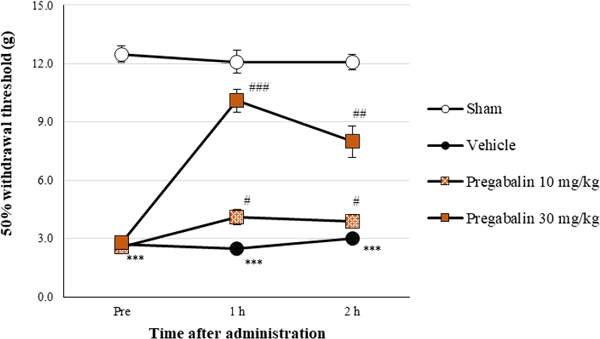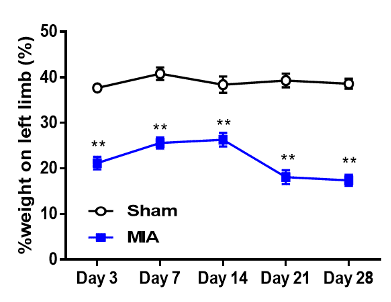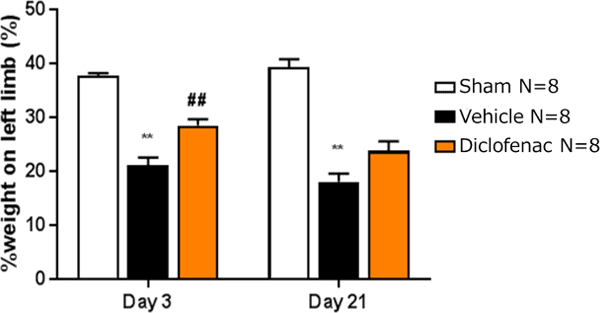BIOSCIENCE Pharmacological studies
Pain
Pain
| Neuropathic pain | PSL model, Seltzer model (mouse) CCI model, Bennett model (mouse, rat) SNL model , Chung model (rat) SNI model (mouse) |
|---|---|
| Diabetic neuropathic pain | Streptozotocin(STZ)-induced diabetic neuropathic pain (rat) |
| Chemotherapy-Induced Peripheral Neuropathic Pain (CIPN) model (rat) | Paclitaxel-induced peripheral neuropathic pain model (rat) Oxaliplatin-induced peripheral neuropathic pain model (rat) |
| Inflammatory pain | CFA model (rat) |
| Knee osteoarthritis model | MIA-induced knee osteoarthritis model (rat) Medial meniscectomy (rat) Silver nitrate-induced model (rat) |
| Postoperative pain | Postoperative pain (incisional pain) model (rat) |
| Visceral pain | Caerulein-induced pancreatitis pain model (mouse) |
| Acute pain | Formalin test (mouse) |
We establish models not listed on the website ad libitum. Feel free to contact us.
Evaluation of pharmacological effect of pregabalin in CCI model (rat)

Dynamic weight bearing test in MIA model (rat)


Overview of pain
In selecting an animal pathology model, a protocol is prepared considering the presence of a pathology model for the target disease, whether the pain is acute or chronic, type of pain, target of the analgesic, and timing of administration.

Overview of behavior assessment method
Pain is a subjective symptom and animals cannot say "Ouch!" Therefore, to evaluate an analgesic in animals, "pain-related behaviors" of animals are observed and assessed. As types of pains that develop differ by pathological model, behavior assessment is selected in accordance with the pathological model. The subjective view of the experimenter tends to affect the results of behavior assessment, and some devisal is therefore required such as measuring in a blinded condition. Additionally, the experimental condition should be set such that the animals can take avoidance behaviors with defining the cut-off value for each measurement.
| Type of stimuli | Measuring method |
|---|---|
| Mechanical stimulus | von Frey test |
| Cold stimulus | Acetone test |
| Thermal stimulus | Hot plate test Plantar test |
| Without stimulus | Evaluation |
|---|---|
| Static weight bearing ratio (static pain) | Weight bearing test |
| Dynamic weight bearing ratio (ongoing pain) | Dynamic weight bearing test |
| Other | Observation of behaviors such as abnormal gait |
Explanation of pathological models
| Model | Evaluation |
|---|---|
| Partial sciatic nerve ligation (PSL, Seltzer)model |
von Frey test |
| Chronic constriction injury (CCI)model |
von Frey test |
| Spinal Nerve Ligation (SNL, Chung)model |
von Frey test |
In nerve ligation model, the occurrence of pain in the model is affected by material of the thread, size, and position and strength of the procedure. Therefore, experimenters should always perform the procedure in accordance with a certain standard. Pain may not persist long if it develops weakly and the drug may not act well if it develops too strongly. Thus, efforts should be made to induce pain uniformly within the model. The timing of onset of stable allodynia differs by model. KAC mainly uses pregabalin as a positive control.
| Model | Evaluation |
|---|---|
| Paclitaxel-induced peripheral neuropathic pain model | von Frey test |
In clinical settings, peripheral neuropathic pain develops in about 60% to 80% of patients. The severity of the symptom depends on the total dose and treatment duration. Although clinical neurological symptoms occur as numbness and pain, it is difficult to assess numbness and pain separately in animal models. KAC often measures them by von Frey test in analysis. KAC mainly uses pregabalin as a positive control.
| Model | Evaluation |
|---|---|
| Oxaliplatin-induced neuropathic pain model | Acetone test |
In clinical settings, oxaliplatin-induced peripheral neuropathy is classified in acute symptoms and chronic symptoms. Acute symptoms include cold allodynia in almost all patients within several days after treatment with oxaliplatin. Then, repeated treatment with oxaliplatin causes chronic neuropathy (numbness and hypoesthesia) at a high incidence.
Cold allodynia is assessed by several methods including acetone test, tail immersion test, and cold plate test. KAC adopts acetone testing. Cold allodynia results in such a weak response in animals that it is difficult for experimenters to recognize it.
While cold allodynia develops immediately after treatment with oxaliplatin in clinical settings, rats and mice do not exhibit pain-related behaviors immediately after treatment with oxaliplatin (or experimenters cannot recognize that), and therefore, multiple oxaliplatin treatments are often conducted in much of the literature. KAC mainly uses duloxetine as a positive control.
| Model | Evaluation |
|---|---|
| Streptozotocin(STZ)-induced diabetic neuropathic pain model | Blood glucose test von Frey test |
Streptozotocin is administered to induce diabetes mellitus in rats. This model has great variation between strains. In the treatment condition in KAC, almost all animals have hyperglycemia after treatment with STZ. On the other hand, mechanical allodynia does not develop in all animals. Care should be taken so that behavior assessment is not affected by increasing urine volume. KAC mainly uses pregabalin as a positive control.
| Model | Evaluation |
|---|---|
| MIA-induced knee osteoarthritis model (rat) | Weight bearing test Dynamic weight bearing test von Frey test (supplementary) |
The models are created by administering MIA into the articular cavity. As experimenters cannot visually recognize whether MIA has been administered in the articular cavity, some devisal is required to assure MIA administration. Acute pain develops 1 to 3 days after the administration of MIA, followed by the onset of chronic pain 3 to 4 weeks after the administration, with a difference by MIA dose.
NSAIDs or morphine are used as positive control in acute phase and morphine in the chronic phase.
Static pain is measured by static weight bearing test and pain on motion in dynamic weight bearing test. In static weight bearing test, the weights born to the bilateral legs differ by posture or face position of the animals in the test cage. Acclimatization of animals to the measurement is therefore important.
Dynamic weight bearing test requires no consideration of acclimatization as described above because it involves mechanical measurement. However, if animals become acclimated to the measuring device, they may not walk, and measurement should therefore be conducted at some interval.

| Model | Evaluation |
|---|---|
| Medial meniscectomy (rat) | Dynamic weight bearing test von Fray test (supplementary) |
While MIA model induces pain by administering a chemical, medial meniscectomy model induces pain by resecting the meniscus and is said to be more similar to the clinical pathology. However, the surgical procedure is difficult because the joints of rats are small. The surgery is conducted within a small visual field, requiring measures to avoid damage to other tissues.
The pain is milder than that in MIA model and persists for a certain period.

[ close ]
